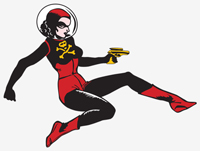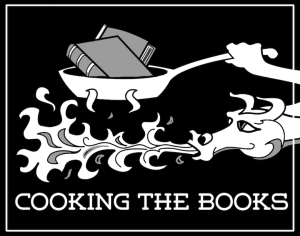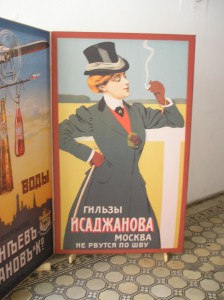As we mentioned earlier this year: The Otherwise Award had a hiatus a few years ago, then restarted last year. So we didn’t convene juries to celebrate works published in 2022 and 2023.
We don’t currently plan to give out Otherwise Awards for those years, but we would still like to spotlight gender-expanding genre fiction you may appreciate, and to encourage and celebrate people who created noteworthy work.
So, to help with this, we’ve invited some friends of Otherwise to recommend genre work they loved from those years. We are sharing those informal recommendations in a series of blog posts. The first was in August, the second was last month, and here’s the final batch!
2022: Vagabonds! by Eloghosa Osunde
Eloghosa Osunde’s polyphonic, magical debut novel, Vagabonds!, is one of the most spectacularly queer books I’ve had the joy of reading—queer in the sense of refusing to abide by others’ norms, queer as in troubling borders and boundaries, queer as in entirely unique and also defiantly in community. A vagabond, according to the book’s introduction, is “an outsider, an unbelonger, unforgettably unloved.” A person who dresses in the fashion of the opposite gender, who fails to adhere to society’s rules. “In other words: invisible, hypervisible, threat, trouble.” The novel takes seriously the weight of living beneath these labels, under this sort of scrutiny, but it also insists upon hope, joy, the possibility of reclamation. An exclamation point turning a label into a rallying cry. In an interview, Osunde talks about the power of “stories that imagine us with more abundant options than conform or die… stories written by people who can see us flourishing without fleeing.” Vagabonds! is a compendium of such stories, gorgeously written and imagined. (Recommended by Emet North)
2023: The Deep Sky by Yume Kitasei
In some ways, Kitasei’s The Deep Sky follows in the feminist SF tradition of woman-only worlds, part of feminist SF and utopian writing since, well, the 16th century. Set on a woman-only deep space mission, the story ostensibly is a murder mystery—in fact, I first came to it when searching for mystery novels and not science fiction ones—in which an 80-women crew of the mission try to figure out who sabotaged the mission and blew up one of its crew. The novel is told from the point of view of Asuka, who we learn via multiple flashbacks to the crew’s education, training, and selection that takes place on Earth, was not originally selected for the mission. As with many women-only groups, “traditional” gender stereotypes lose their meaning and we get to see all the crew as people, with all their flaws and shortcomings as well as their individual strengths. The twist is that everyone on the crew needs to be able to get pregnant as this mission is meant to preserve humanity by sending the ship to a habitable planet—thus some crew members identify as men or non-binary in addition to those who identify as women. I found the updated version of this “women-only” space to be intriguing. The space is both inclusive and completely exclusionary, due to physical attributes, nationality, and other sometimes questionable criteria. The story, characters, and underlying pushing of what we mean by gender, kept me involved in the story—as did the extensive use of virtual reality by the characters. (Recommended by Rebecca J. Holden)
2023: The Water Outlaws by S.L Huang
The Water Outlaws is a reimagining of the Chinese classic Water Margin, set in an imperial China-inspired fantasy world that interrogates the rigidity of gender norms and their deep entanglement with hierarchical and oppressive systems. The story follows Lin Chong, a disciplined and loyal arms instructor in the Empire’s army, whose faith in the system is shattered when she is punished for rejecting the obsession of a powerful man. Cast out and branded a criminal, she joins a band of rebels who are fighting not only against the Emperor’s corruption but also against the very structures that define justice, power, and identity. These outlaws are a morally complex and diverse group, many of whom live openly as queer, trans, or gender-nonconforming individuals. Huang presents their identities not as anomalies but as acts of resistance- living freely outside the Emperor’s binary rules becomes a political and personal rebellion. The novel illustrates how punishing difference is a deliberate strategy to suppress freedom and maintain elite control, compelling readers to reflect on the continued policing of queerness and gender in modern systems. While rooted in historical fantasy, The Water Outlaws resonated powerfully in the present, prompting us to not feel secure in a time when elite control continues to try and claw back control. (Recommended by Eleyna Haroun)
2022: “If You Find Yourself Speaking to God, Address God with the Informal You” by John Chu
This novelette offers a splendid examination of queer masculinities, with so much richness of detail about everything from weightlifting to the life of a working actor in musical theater. It also goes deep into examining being Asian American at a time of increased racism in the US. Finally, it’s also a superhero story that engages with the roots of the genre in anti-racism and at the same time, is also strikingly contemporary in the way it is being told; we’re not retreading well-trodden ground, but rather seeing something familiar with fresh eyes. John Chu provides a masterclass in fitting so much into a small space without making the story feel overcrowded — everything flows together and will stay with you for a long time. (Recommended by Bogi Takács)
2023: A Feast for Flies by Leigh Harlen
This is a novella that shows not only queerness but queer communities in a way that feels true to life: it’s not just the queer bar, but also the queer hairdresser, and all the fine details about how one chooses to present and why. It also focuses on not just queer, but specifically disabled queer lives with a carefully considered interior perspective even when the approach is SFnal. Have you wanted a disability-informed take on psychic powers? You get that here. Have you wanted a story where a service animal is an integral part of the telling? You get that too. We also see a situation where one is in a marginalized position and yet enforcing the will of an oppressor, and the protagonist’s attempts to get out of it while staying true to herself — I am always looking for this theme, and here it is done with great care and depth. Finally, A Feast for Flies is also a crackling, twisty noir tale that satisfied my need for adventure and conspiracy. (Recommended by Bogi Takács)
Thanks to all the people who nominated works for 2022 and for 2023, and who contributed to this series of informal recommendations blog posts. Please enjoy!





